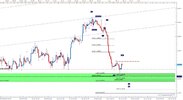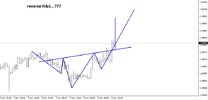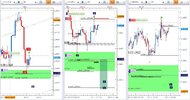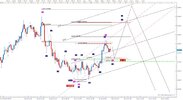Hello!
Analyzing Big time frames, such as Yearly, is very close to science fiction or at least to art and for trading is for most of retail traders also useless but it is important to have a picture what to expect in (near) future.
I start my Yearly count with low in 1985 @0,6382 when pictures for spot and futures have same lowest level, before this low they have different pictures. I find as most possible Zig Zag pattern with Triple sideways corrective B wave developing. I think that two of corrections, both Flats, are ended at 2008 peak @1,6038 and I believe we are in third correction now. If it is to believe Elliott wave masters then we expect either Flat either Triangle as third correction and we can also expect low of this third corrective wave in price area of blue Yearly A, below 1,3119, where it will really move stop is currently impossible to say and even predict until second leg/wave high of this third correction will take place. Just for intermezzo I would like to say that I expect lowest low around parity.
Picture1: EURUSD Yearly chart
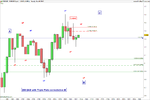
I would skip discussion about both of corrections I treat as finished and would like to concentrate to third correction which is developing. As said we should expect Flat or Triangle as last, third correction in Yearly wave B. For analyzing purposes I prepared two charts, 6 Months and Quarterly to check constructions in waves/legs.
First I intend to check option if Flat as third correction is developing from 1,6038 high, labeled blue cFY. Flat is 3-3-5 waves correction and as seen in charts 6M has hidden first 3 waves in leg/move down to 1,1877 but Q shows 3 waves nicely and 1,1877 low is also Yearly low swing fractal, labeled with red aFY. Then follows move up to 1,4940, from these both charts I can just assume as Zig Zag (3 waves leg) because of long wicks. Move down to 1,2042 also looks like Zig Zag because of enormous wick and overlapping candles in second half of move. So, based on clear shapes on Quarterly I assume that last, third leg is in progress and I expect it will be motive wave with shape of Ending Diagonal or less probable Impulse, all three legs together compose Flat correction into red Yearly bFY. Target of this move is at least 50% of red aFY, this means price level 1,3958 minimum, but maximum height is muchmuch more, above 1,6038, so much, I think it is unreal to expect to be reached. What I like in this assumption is also timing, because we are closing to new year and with peak in next year we do not get only Yearly swing high fractal, which I somehow expect, but it is very possible also regarding all pressures on USA politics regarding money printing & value of USD. The other possible development of this leg from 1,1877 low is Double Zig Zag shape, limited with higher high from 2008 @1,6038, which I do not consider impossible but not acceptable from timing stand point of view – it would take too much time to develop properly and especially regarding stock market balloon. Of course I can be wrong but I think the only possibility that USD falls of a cliff is that whole world will turn back to it and not consider it as safe heaven!
Picture2: EURUSD 6Months & Quarterly charts
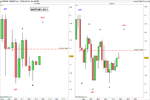
Now I will pay my whole attention to last move up from 1,2042 low and try to find the most probable pattern to match my overall picture. For this purpose I change the chartist because of ProRealTime limitations and switched to FXCM.
What I expect most is Motive wave, either Ending diagonal, either Impulse so let´s check possibility for Ending diagonal for now, and if necessary I will check other possibilities. I just want to say that even if there Leading diagonal is developed as first wave of an Impulse, price action will not be different in first stages.
Monthly chart shows three legs/waves and let´s assume that whole Ending diagonal pattern will develop as one single wave up on 6M, and maybe even Q, chart. I think first wave up could be 1 of Ending diagonal, seen on both weekly charts. First weekly chart is made under assumption that wave 3 and temporary top is in place, and with a possible twisted idea of Triple ZZ for 3ED (pink labeled). This option I do not like a lot because it has too much phony waves although is nicely finished with 100% abc wave. Task and goal is to establish swing low fractal and Monthly target level is 1,31037 minimum BUT must not even touch lower channel line around 1,2850.
Second weekly option I find much more attractive and possible. Here not so many legs/waves are under question, just from 1ED to 2ED and last wave a has strange construction and was misleading till the low established yesterday! Target of current wave b down is at least to touch c=w peak @1,34156 or/and to enter below in the territory between w&x BUT not to exceed x @1,31037. Weekly candle is big, huge, more than 300 pips and a retrace would be really nice and to expect but the primary target is extremely close to current price level, just 50-60 pips and very close is also 61,8 retracement! Currently the price is sitting on 50% retracement and I think that touching at least 1,34156 peak is veryvery possible before higher so watching for harmonic pattern such as crab, developing on H1 at the moment, is not bad decision. Such move would not change a thing before Thursday as ECB´s D Day and from which so much is expected, especially to the downside.
Picture3: EURUSD Monthly&Weekly Ending Diagonal
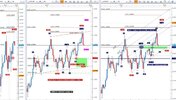
Conclusion: I think we will get a retrace, and if the price hits 1,34156 or 62% retracement @1,3380 first, it could develop into more than just retrace.
Good trading!
Analyzing Big time frames, such as Yearly, is very close to science fiction or at least to art and for trading is for most of retail traders also useless but it is important to have a picture what to expect in (near) future.
I start my Yearly count with low in 1985 @0,6382 when pictures for spot and futures have same lowest level, before this low they have different pictures. I find as most possible Zig Zag pattern with Triple sideways corrective B wave developing. I think that two of corrections, both Flats, are ended at 2008 peak @1,6038 and I believe we are in third correction now. If it is to believe Elliott wave masters then we expect either Flat either Triangle as third correction and we can also expect low of this third corrective wave in price area of blue Yearly A, below 1,3119, where it will really move stop is currently impossible to say and even predict until second leg/wave high of this third correction will take place. Just for intermezzo I would like to say that I expect lowest low around parity.
Picture1: EURUSD Yearly chart

I would skip discussion about both of corrections I treat as finished and would like to concentrate to third correction which is developing. As said we should expect Flat or Triangle as last, third correction in Yearly wave B. For analyzing purposes I prepared two charts, 6 Months and Quarterly to check constructions in waves/legs.
First I intend to check option if Flat as third correction is developing from 1,6038 high, labeled blue cFY. Flat is 3-3-5 waves correction and as seen in charts 6M has hidden first 3 waves in leg/move down to 1,1877 but Q shows 3 waves nicely and 1,1877 low is also Yearly low swing fractal, labeled with red aFY. Then follows move up to 1,4940, from these both charts I can just assume as Zig Zag (3 waves leg) because of long wicks. Move down to 1,2042 also looks like Zig Zag because of enormous wick and overlapping candles in second half of move. So, based on clear shapes on Quarterly I assume that last, third leg is in progress and I expect it will be motive wave with shape of Ending Diagonal or less probable Impulse, all three legs together compose Flat correction into red Yearly bFY. Target of this move is at least 50% of red aFY, this means price level 1,3958 minimum, but maximum height is muchmuch more, above 1,6038, so much, I think it is unreal to expect to be reached. What I like in this assumption is also timing, because we are closing to new year and with peak in next year we do not get only Yearly swing high fractal, which I somehow expect, but it is very possible also regarding all pressures on USA politics regarding money printing & value of USD. The other possible development of this leg from 1,1877 low is Double Zig Zag shape, limited with higher high from 2008 @1,6038, which I do not consider impossible but not acceptable from timing stand point of view – it would take too much time to develop properly and especially regarding stock market balloon. Of course I can be wrong but I think the only possibility that USD falls of a cliff is that whole world will turn back to it and not consider it as safe heaven!
Picture2: EURUSD 6Months & Quarterly charts

Now I will pay my whole attention to last move up from 1,2042 low and try to find the most probable pattern to match my overall picture. For this purpose I change the chartist because of ProRealTime limitations and switched to FXCM.
What I expect most is Motive wave, either Ending diagonal, either Impulse so let´s check possibility for Ending diagonal for now, and if necessary I will check other possibilities. I just want to say that even if there Leading diagonal is developed as first wave of an Impulse, price action will not be different in first stages.
Monthly chart shows three legs/waves and let´s assume that whole Ending diagonal pattern will develop as one single wave up on 6M, and maybe even Q, chart. I think first wave up could be 1 of Ending diagonal, seen on both weekly charts. First weekly chart is made under assumption that wave 3 and temporary top is in place, and with a possible twisted idea of Triple ZZ for 3ED (pink labeled). This option I do not like a lot because it has too much phony waves although is nicely finished with 100% abc wave. Task and goal is to establish swing low fractal and Monthly target level is 1,31037 minimum BUT must not even touch lower channel line around 1,2850.
Second weekly option I find much more attractive and possible. Here not so many legs/waves are under question, just from 1ED to 2ED and last wave a has strange construction and was misleading till the low established yesterday! Target of current wave b down is at least to touch c=w peak @1,34156 or/and to enter below in the territory between w&x BUT not to exceed x @1,31037. Weekly candle is big, huge, more than 300 pips and a retrace would be really nice and to expect but the primary target is extremely close to current price level, just 50-60 pips and very close is also 61,8 retracement! Currently the price is sitting on 50% retracement and I think that touching at least 1,34156 peak is veryvery possible before higher so watching for harmonic pattern such as crab, developing on H1 at the moment, is not bad decision. Such move would not change a thing before Thursday as ECB´s D Day and from which so much is expected, especially to the downside.
Picture3: EURUSD Monthly&Weekly Ending Diagonal

Conclusion: I think we will get a retrace, and if the price hits 1,34156 or 62% retracement @1,3380 first, it could develop into more than just retrace.
Good trading!
